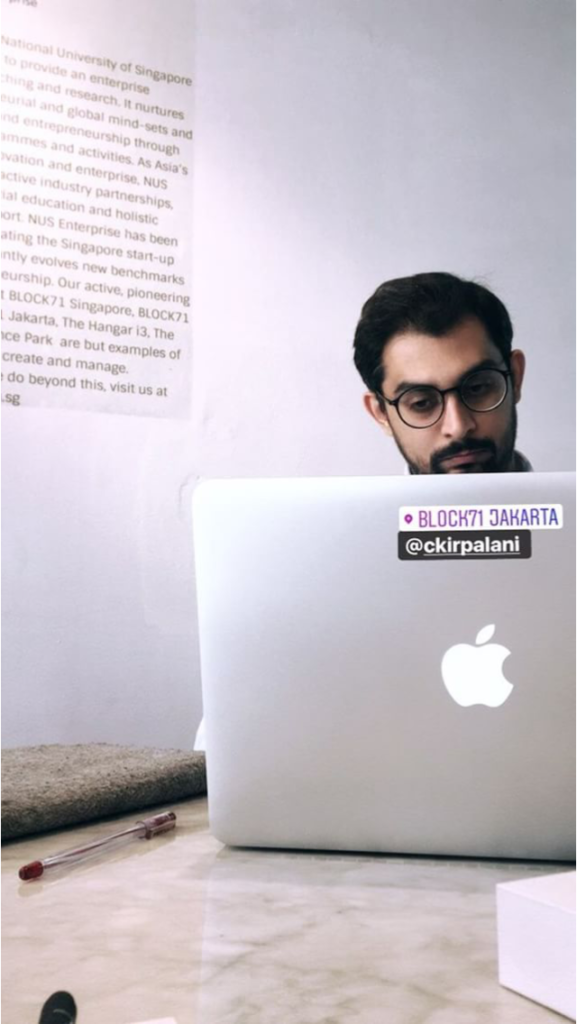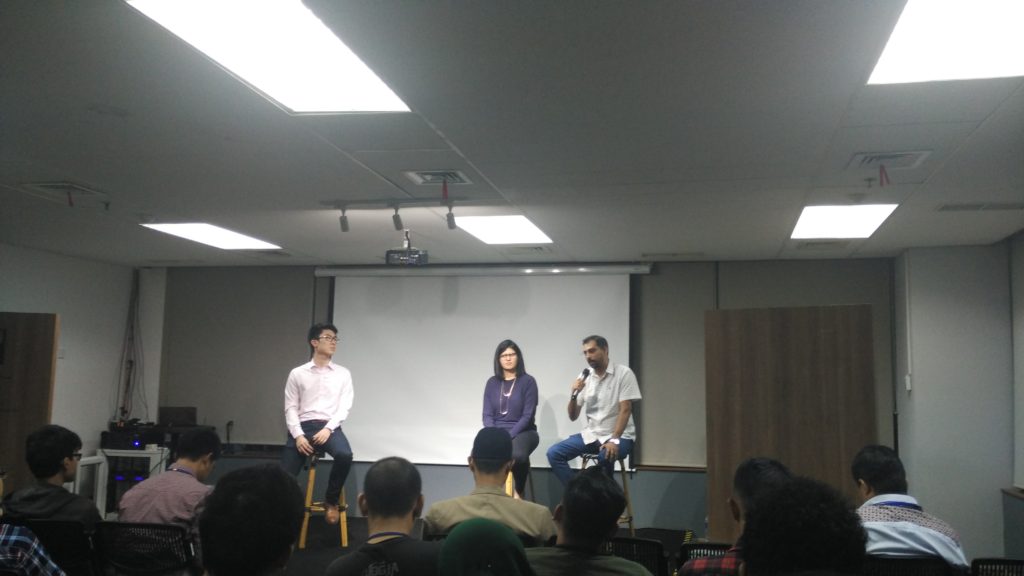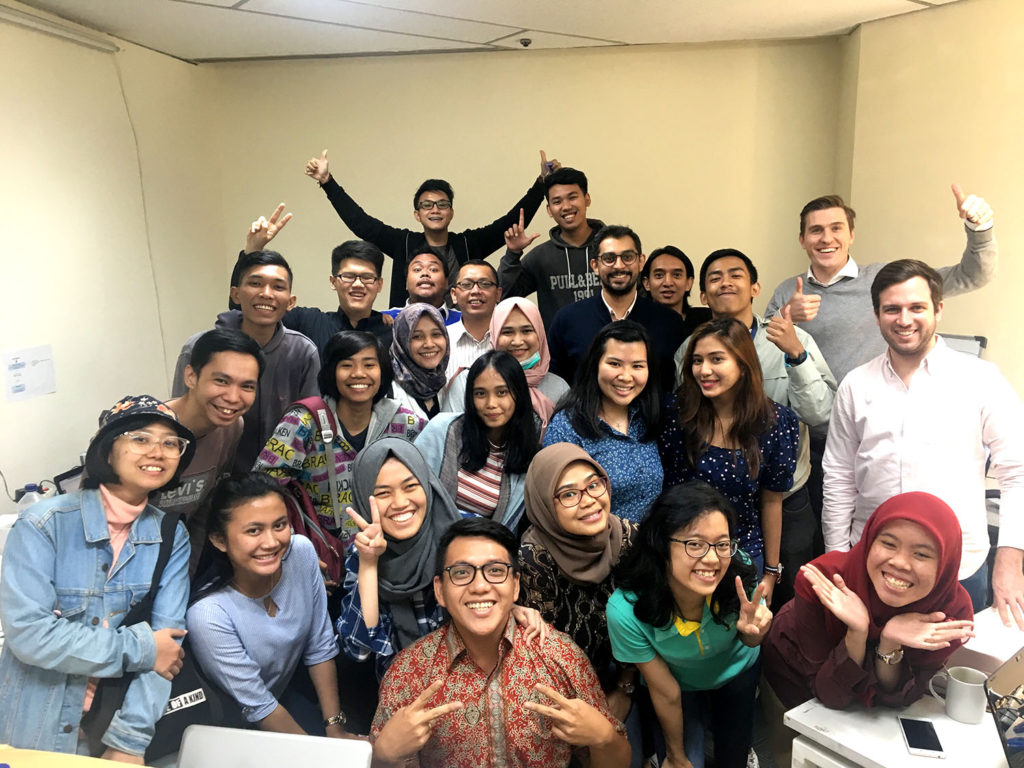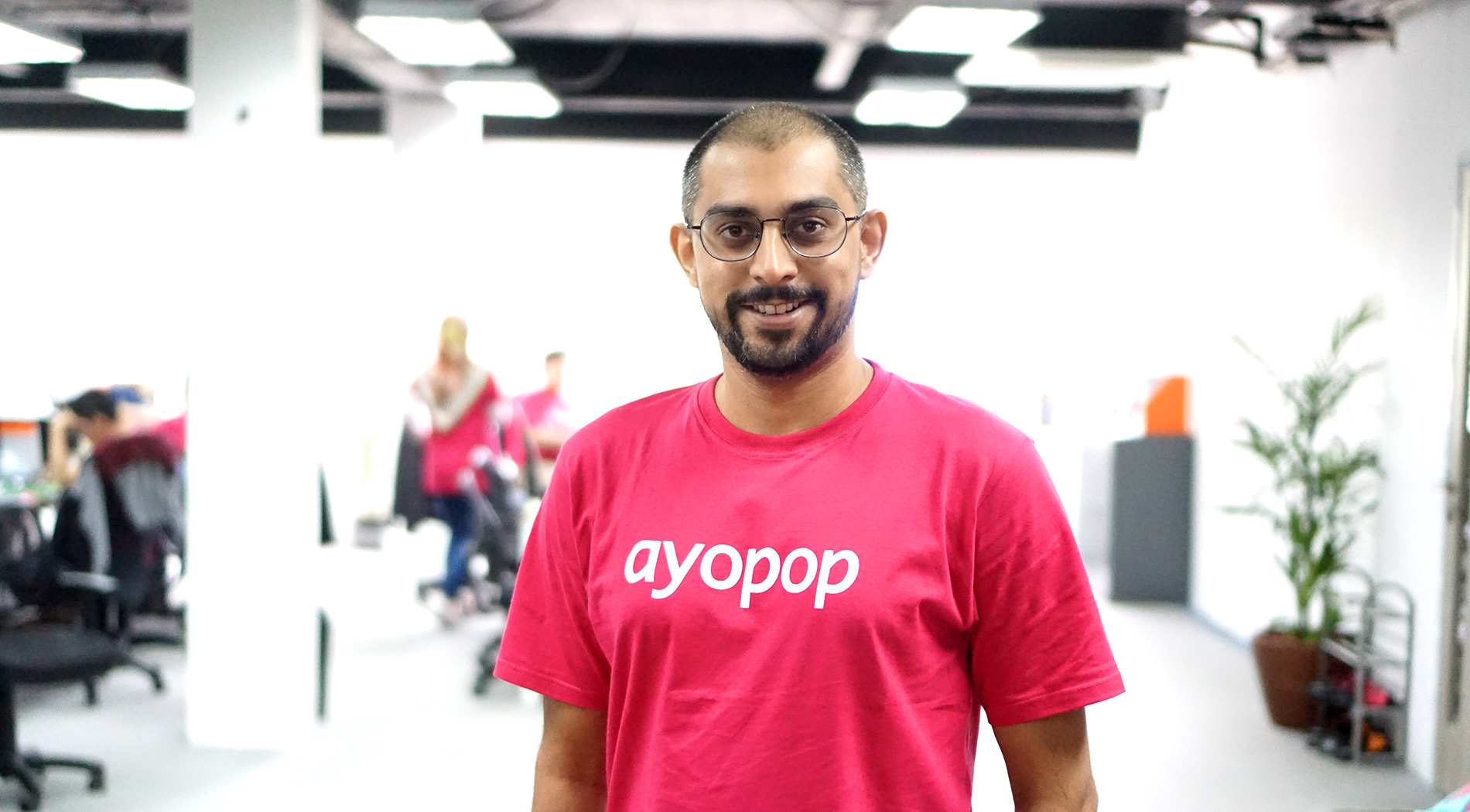
“Our conversation with Chiragh Kirpalani gave us great insights into the South-Asian Fin-Tech world, the challenges of an Island Nation and how the knowledge of UI/ UX helped him build ground-breaking brands.”
With an enormously creative mind, Chiragh has a proven track record of strategizing innovative solutions and is a well-acclaimed serial entrepreneur. Having worked as a Product Designer and as a Product Manager, Chiragh now is the CXO of Ayopop, a Fin-Tech start-up which he co-founded in 2016. Ayopop is Indonesia’s largest bill aggregating network. Before Ayopop, he founded a food-tech start-up and also contributed to a U.S based start-up named Fab.com whose growth exploded in the early 2010s. He holds remarkable understanding in the fields of User experience, Product Management and Business Technology. Chiragh completed his Bachelors in Design (UX Design) from Symbiosis International University, Pune in 2009.
One glance over his work is good enough to make one realize that DESIGN was in his veins!
His energetic voice and calm composure were enough to ensure us that this discussion was going to be fascinating for us and our readers.
The First Wave of Internet Companies:
Born and brought up in Indonesia, Chiragh spent many years experimenting with ideas and work profiles after his Bachelors in India.
It was when he noticed the first wave of Internet Companies that he decided to return back to Indonesia. He saw this rise of internet companies as an opportunity to create a market and to make the lives of the citizens much better. This would also provide him with a market mover advantage.
He adds that Indonesia is now one of the largest growing markets in South-east Asia. Besides, he also states that there is a significant spike in the number of people buying smartphones and accessing the internet in recent times. This helps Ayopop leverage an opportunity to help people get used to habits they never had.
The companies which started three to five years ago during the first wave of the internet have now begun to prosper.
The Experiences of Solving ‘First-Time User’ Issues:
Just like any new product, especially those that are completely new to a market, Ayopop also had a fair share of problems.
While talking about the first time users of Ayopop and how his team solved their problems, he says,
“During the launch of Ayopop, internet awareness was very low and making payments through an app was relatively new for people. The team had to implement offline measures to create awareness about an internet product!”
Considering this issue, the team took subset users who had been familiar to Ayopop and helped the new users learn from them. Besides, they also set up booths which educated the people and helped them understand and use the app. The booths were not only a guideline for the users but they also convinced customers that they were benefitting from the app. The design of the app which emphasized the savings using Ayopop as compared to offline payments was itself a shout out for them. Apart from that, localized language and simple words made the user experience better due to which the first-time users could overcome barriers.
Major UX Improvisations to Increase Conversion Rate:
Chiragh believes it’s not only about the design but also the placement of certain components when it comes to UX. To explain this he takes the example of his startup, Ayopop.

In order to increase conversion rate, Chiragh talks about the UX move which Ayopop took at the payment’s page. They started making enhancements at the final payments page. One of them was giving a breakup of the total bill mentioning the MDR charges and the actual price of the products. Besides he gave an example stating they showed a price comparison while people made mobile recharges showing them the benefits when done through Ayopop instead of the traditional method.
Lastly, he mentions about the strategy where he adds a pinch of marketing into UX. That is to place promo offers on the home screen which are basically not promos/discounts but convince people that they are.
An Insight into the Educating Booths:
Chiragh explains that they started booths in 2016 to make people familiar with their app and understand their behaviour towards the app. This activity was done in the initial days after launch and for a smaller segment of customers which was initially an expensive activity. Talking about the recent years, he shares that his team visited cities and invited 10 users in each city for dinner and took their feedback about their app. Besides they also created such ‘user-focused groups’ in rural areas as well which put light on the needs of the users. Sharing an instance from the same he says,
“While designing the history screen we used to give the list of transactions but these guys wanted it in a folder format. So, if it’s an electricity bill, it should be put in one folder. Just like they used to do in their own lives where they physically stack it up into one file.
Further, he also emphasizes the importance of a UX Researcher team for business. He says,
“We hired a UX Researcher who connected the users and documented more about their journey, shadowed the users to observe how they interact with the buttons and understand where to make significant changes.”
Thus, he mentions that UX is generally seen by businesses from a return on investment perspective. But rather it should be seen as a necessity in order to understand what problems users are facing.
Apart from just talking to the users, he believes it is also necessary to check where the funnel of customers is actually broken. Whether it’s conversion, acquisition or activation, it could be found out from analytic tools. So basically, understanding the problem gives validation to the UX Researcher and helps solve issues accordingly. He says,
“We used to do mock-screens and get it to the field and get validation from them. To make the most of our user-focused groups we even created WhatsApp mini-groups and shared our designs with the city leaders to get feedback.”
How to Maintain Familiarity While Changing the UX of an App?
UX changes often tend to snatch away the familiarity that a user has with a product. This can also prove to be adverse if not handled well.
To solve this, Chiragh recalls his experiences from the bigger companies that did not roll out the releases of features all together. Instead, they set certain thresholds for the users who will witness the change. He explains this with the example of the tech giant, Instagram. He mentions how Instagram brought in the ‘dark mode’ feature but it first allowed it only for a specific segment of users or regions. In the same way, one needs to understand the performance of the changed UX and then gradually roll it out for the entire segment.
To illustrate this, he shared an instance from his work where they wanted to personalize the home screen so they placed only a few icons on it. This change in UX created a sort of confusion in the user who misunderstood as deletion of certain features.
“The category icons were changing on their own, based on algorithms and based on usage. We had personalized the experience. So, if they paid a bill, it didn’t show up for another 30 days as they didn’t have to pay it again. This created a little mess hence we had to roll back to the older design.”
A Word from Chiragh for the Budding UX Entrepreneurs Sharing his Views on the Importance of UX:

Chiragh believes that designers are accustomed to finding out problem areas. He focuses on the understanding of that problem area and to determine if it is big enough to create a business out of it. He shares that as a founder, coming from a design background has exclusively helped him to provide an aesthetic design to his start-up. He calls it the “eye for detailing”. Explaining the importance of designs he says,
“Not many founders are from a design background. Thus, they limit the efforts only until the app/platform is working and usable.”
He gives an insight into the design evolvement of Indian apps where previously the apps were usable and working but not design-friendly. But now people too are having an eye for detailing and aesthetics. He further adds,
“Now the awareness has started to change where people are aesthetically getting more aware of what is good design. People previously did not watch Netflix but now they watch it as Netflix has got really good UX and UI. So they have become accustomed to how things work and how the functionality works.”
Apart from that, he also talks about one of the major things that designers today tend to forget: Transition. The anticipation of a particular thing on the screen so as to where is it coming from and where will it be going, matters. Along with that, the impact in any other functionality of the entire product is supposed to be scoped out as well. He frames,
“The output of the whole quality and the culture of the product itself is built in such a way that the Quality testers, Product Managers or Developers of the app/platform also tend to improve their eye for detailing about every pixel which is not done correctly and the way it’s supposed to transition.”
The Era of Automation:
Chiragh believes that in the coming years Automation is going to play a huge role in the design industry. Although he predicts that while automation would make certain jobs obsolete, at the same time it would also bring in a plethora of opportunities.
“Understanding and trying to merge Business and Data is important. If you know how to merge numbers with design and understand the output, then it would be a great opportunity for you. More and more designers need to clock the creativity and problem-solving skills they have and look at it from a business mindset.”
Thus, he preaches to embrace the automation and be open to the innovations that it is going to bring in the coming years.
The Perfect Balance Between Business and UX:
Business owners sometimes neglect the need for UI/UX due to various reasons such as budget constraints and lack of knowledge about it. Chiragh agrees that business owners in a way are now realizing the importance of good user experience since it also affects revenue and even the sale of a product/transactions on a platform. They are now starting to understand that design is a crucial aspect. Considering this he further mentions that business owners feel that UI and UX are blended and things will work if they improve aesthetically. But that’s not how it would solve problems. He says,
“Business owners should start giving real problem statements and designers also should ask the business owners about the areas where things are not working or where the drop is seen.”
A Key Takeaway for Start-Ups in the Early Stage or Start-Ups which have Failed:
Chiragh talks about a few factors which should be kept in mind by budding entrepreneurs while starting-up. He emphasizes the need for getting the right product-market fit. This he further explains that it is not easy to hit your idea into the market as there is a difference between what you give and what the market wants. The solution is that one needs to observe the behaviour of the customer towards your product and get validation. Chiragh mentions the aspect of ‘Utility’ by giving an example from his own experiences. He shares that it was difficult for his team to initially pinpoint their users and know who they are. To the budding entrepreneurs, he says,
“Get a lesser number of users but get to know them really well. Build a community. Community is super important since it creates the network effect which helps to understand and validate much better. Stickiness towards your solution is the key. Once you build that network and replicate it, then it would be a perfect point to start rather than just directly launching something.”
The Concept of Funding:
Chiragh considers funding as an acceleration to put a business into motion and scale it over time. He believes that there are sufficient numbers of investors and enough funds in the market to provide funding to new start-ups. But according to him, one must look for what more benefit can the investors bring to your company. He says,
“It is important to get people with the right mindset for funding. The question here is what beyond funding can the investors do to help your company’s growth? Are they introducing you to businesses which can help you grow or are they opening doors for new opportunities?”
He also shared that investors too today are looking out for creative ideas and provide funding to them. Hence an approach from both parties is required in that case.
Digitalization in South-Asian Markets:
Chiragh mentions that the industry of Healthcare is in its early stages of digitalization and he believes there are many areas which need to be worked on. He talks about the start-ups that are currently working on the major problems in the Healthcare industry associated with digitalization. But there are still many basic issues which need to be attended.
Besides, he also considers Agri-Tech as another industry which requires improvement in terms of digitalization in an agricultural country like India.
The third industry according to him is Security and Surveillance where he believes people will invest a lot in the coming years. Since people have become quite vulnerable about safety, this industry will show a significant spike in terms of digitalization.

You are often referred to as the ‘Paytm of Indonesia’. What would you comment on it?
Chiragh does not accept being the ‘Paytm of Indonesia’ but instead talks about how his team has been evolving around the years. He shares that in fact, Ayopop is working with many of the wallet players by helping them bridge to the billing providers. His team has been putting in a lot of efforts and that they have witnessed successes and failures throughout the journey. He believes that they are still in the process of making and providing value to the businesses that ultimately helps the people to pay their recurring bills. Besides, Chiragh talks about the stages that their start-up has been from a Seed stage start-up to series ‘A’ start-up and being ready for series ‘B’. Explaining the same he adds,
“We have evolved in a stage to help utility companies to collect their payments. Because the collection is a huge problem and it becomes way more difficult in such pandemic times. Thus, we are focusing on collecting recurring payments in an efficient way and right now that’s our key goal by bridging the utility companies to more and more payment channels.”
What new additions are you looking forward to introducing on your Fin-Tech platform?
Chiragh looks forward to focusing on more use cases since they ultimately result in more transactions. He mentions the areas like local tax and community tax around which they will be making improvements. Insurance is another sector where his team will be working to introduce more insurance companies to digitalization and bring them on his platform. Also, the NBFCs which give small loans to businesses, as well as consumers, are one of the additions that he intends to have on his platform.
Chiragh’s Secret to Continuous Growth and Learning:
Chiragh believes one needs to keep going deep in their own business. According to him, one must focus on the things which would bring leverage in the business and understand what works and what doesn’t. He mentions factors like pricing, marketing spends, network effect, distribution cycle and others as levers of his business which he constantly studies. He says,
“To keep myself updated I make sure that I do meet up with other entrepreneurs. I discuss and exchange my ideas and problems with other like-minded entrepreneurs which helps all of us learn from one another.”
What’s the Next Big Thing in Fin-Tech?
Chiragh believes Concurrent payments would be the next big thing into the Fin-Tech world where people will be able to do multiple payments in one transaction. Auto-debit is another character which will come into the picture in the coming years. India is already in the early stages of auto-debit payments with UPI, he shares.
What key takeaway you would like our readers to take after reading this conversation?
“Establishing a start-up is a long journey. So, make sure you are passionate about what you do and intend to be in it for the long term. Focus on the problem areas and if it’s big enough and you are pretty excited about it, then go for it. Validation is super important. It’s going to be a wonderful journey but the fruits will come much later. So just KEEP AT IT.”
It’s time for a Rapid-Fire Round!
We also had a fun Rapid-Fire Round with Chiragh!
What’s your Bible? Books or blogs?
- Blogs
Videos or Podcasts?
- Podcasts
Which is your favourite book?
- I don’t have any. I rather search content on the Internet by keywords like payments, Fin-Tech etc.
Which is the first app that you use every morning?
Which is your favourite item to cook?
- Omelette. That’s the only thing I can cook : )
Gas Stove or Microwave?
- Gas Stove
Who’s your Fin-Tech Guru?
- Learnt the most from my experience and previous bosses




